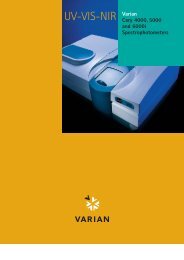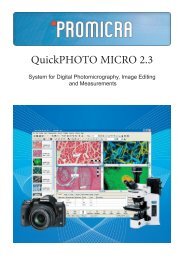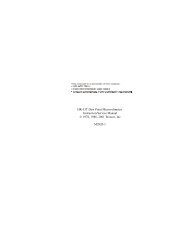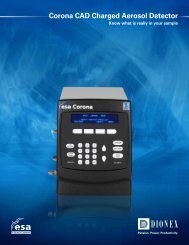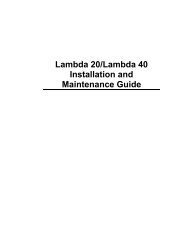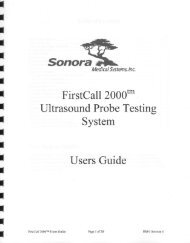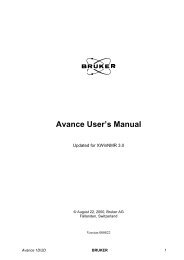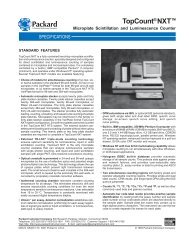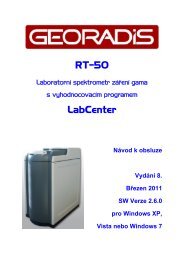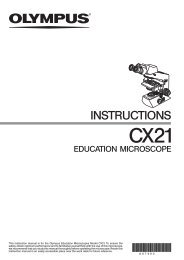Download brochure as PDF - Nikon Instruments
Download brochure as PDF - Nikon Instruments
Download brochure as PDF - Nikon Instruments
You also want an ePaper? Increase the reach of your titles
YUMPU automatically turns print PDFs into web optimized ePapers that Google loves.
CFI60 OBJECTIVES<br />
Markings on CFI60 Objectives<br />
Condensers<br />
2.5 58<br />
21<br />
ø27<br />
ø8<br />
30˚<br />
ø50<br />
14.5 6<br />
7.5<br />
(1) Magnification and Color Code<br />
A color coded ring on the barrel identifies<br />
the magnification of the objective:<br />
(2) Numerical Aperture (N.A.)<br />
N.A. is the most important factor in defining<br />
the performance characteristics of an objective.<br />
N. A.= n sin <br />
n: the refractive index of the media at d-line (587nm)<br />
For dry objective n=1.000 (air)<br />
For oil objective n=1.515 (oil)<br />
For water objective n= 1.333 (water)<br />
:Half angle of incident rays to the top lens of the objective<br />
The higher N.A., the higher resolving power.<br />
When the resolving power is defined <strong>as</strong> the power to<br />
recognize the two points,<br />
R=<br />
or<br />
(1) Magnification (2) Numerical Aperture<br />
(6) Application Markings<br />
<br />
N.A.<br />
R=<br />
<br />
N.A. Obj. +N.A. Cond.<br />
The higher N.A. the brighter image we take.<br />
2<br />
Brightness: B <br />
N.A.<br />
Total Magnification <br />
The higher N.A., the shallower the depth of focus (DOF).<br />
DOF = N.A. 2<br />
(1) Color Code<br />
(7) Immersion Oil—cleaning<br />
Mag. 1X 2X 4X 10X 20X 40X 50X 60X 100X<br />
Color code Black Gray Red Yellow Green<br />
Light<br />
Blue<br />
Light<br />
Blue<br />
Cobalt<br />
Blue<br />
White<br />
(3) Working Distance<br />
Working distance (W.D.) defines the distance between<br />
the top lens of the objective and the surface of the<br />
cover gl<strong>as</strong>s.<br />
CFI60 objectives can offer longer working distance with<br />
high numerical aperture.<br />
(3) Working Distance<br />
<strong>Nikon</strong> offers a wide variety of CFI objectives. To <strong>as</strong>sist the user they are clearly marked with information<br />
on the objective barrel such <strong>as</strong>: which DIC module or Ph<strong>as</strong>e Ring to use.<br />
n = 1.515<br />
Oil<br />
n = 1.000<br />
Dry<br />
Objective lens<br />
<br />
Cover Gl<strong>as</strong>s<br />
Slide Gl<strong>as</strong>s<br />
(4) Correction Ring<br />
Dry objectives with high Numerical Aperture are<br />
susceptible to spherical and other aberrations which<br />
can impair resolution and contr<strong>as</strong>t when used with a<br />
cover gl<strong>as</strong>s whose thickness differs from the specified<br />
value. A 1 1/2 cover gl<strong>as</strong>s (0.17mm thick) should be used<br />
<strong>as</strong> standard, however not all 11/2 cover gl<strong>as</strong>ses are<br />
exactly 0.17mm and many specimens have media<br />
between them and the cover gl<strong>as</strong>s. The correction ring<br />
is used to adjust for these subtle differences to ensure<br />
the optimum objective performance.<br />
How to use the correction ring<br />
Position the ring at 0.17. The thickness of the<br />
standard cover gl<strong>as</strong>s is 0.17mm.<br />
Focus the lens on a small artifact in the specimen.<br />
Rotate the ring very slightly and focus the lens again<br />
to check if the image h<strong>as</strong> improved or degraded.<br />
Repeat the above step to determine if the image is<br />
improving or degrading in the direction you are<br />
turning the ring.<br />
If the image h<strong>as</strong> degraded, follow the same<br />
procedure in the opposite direction to find the<br />
position offering optimum resolving power and<br />
contr<strong>as</strong>t.<br />
(5) Cover Gl<strong>as</strong>s<br />
For optimum performance, the thickness of the cover<br />
gl<strong>as</strong>s should be 0.17mm. For example, at N.A.=0.95, a<br />
0.01mm difference in thickness reduces image<br />
formation by 45% from the ideal image.<br />
N.A.<br />
0.3<br />
0.45<br />
0.7<br />
0.85<br />
0.95<br />
Difference in cover gl<strong>as</strong>s thickness<br />
0.01mm<br />
0.02mm<br />
100%<br />
100<br />
98<br />
81<br />
45<br />
(4) Correction Ring<br />
(5) Cover Gl<strong>as</strong>s<br />
100%<br />
100<br />
92<br />
43<br />
29<br />
(6) Application Markings<br />
DIC: for Differential Interference Contr<strong>as</strong>t<br />
DM: Ph<strong>as</strong>e contr<strong>as</strong>t, Dark contr<strong>as</strong>t middle type<br />
DL: Ph<strong>as</strong>e contr<strong>as</strong>t, Dark contr<strong>as</strong>t light type<br />
DLL: Ph<strong>as</strong>e contr<strong>as</strong>t, Lower contr<strong>as</strong>t type<br />
(7) Immersion Oil—cleaning<br />
After using immersion oil, gently blot the lens dry with<br />
lens tissue. Then slightly moisten a piece of lens tissue<br />
with petroleum benzene (Naphtha) and clean off all<br />
traces of the oil from the immersion objective. Cleaning<br />
is essential for water immersion objectives <strong>as</strong> well; after<br />
use, wipe the water off the top lens.<br />
Type N.A. Object distance (mm) Magnification<br />
C-C Abbe Condenser, Dry Type 0.9 1.9 4–100x<br />
C-C Achromat Condenser 0.8 4.2 4–100x<br />
Achromat Swing-out Condenser 0.9/0.22 1.8 2–100x<br />
C-C Achromat /Aplanat Condenser 1.40 1.6 10–100x<br />
LWD Achromat Condenser 0.65 10.2 4–40x<br />
C-C Low Power Condenser 0.13 10.2 1–4x<br />
Dark Field Condenser, Oil 1.2–1.43 1.5 20–100x<br />
Dark Field Condenser, Dry 0.8–0.95 4.0 20–40x<br />
16 17<br />
1.0<br />
(Slidgl<strong>as</strong>s thickness)<br />
55<br />
10<br />
R40<br />
ø55<br />
ø43<br />
ø40<br />
ø54<br />
ø59<br />
0.7<br />
8 54.9<br />
55.6<br />
C-C Abbe Condenser, Dry Type<br />
8 55.5 1<br />
(Slidgl<strong>as</strong>s thickness)<br />
0.6<br />
(Oil)<br />
54.4 -0.2<br />
0<br />
70˚<br />
ø54<br />
Achr-ADl N.A=1.4 JAPAN<br />
1.4 1.2 1.0 0.8 0.6 0.4 0.2<br />
ø40<br />
ø62<br />
C-C Achromat /Aplanat Condenser<br />
55 0.5<br />
14 9.5 (Oil)<br />
20<br />
70˚<br />
ø39<br />
ø34.5<br />
Dark Field Condenser<br />
Oil 1.43-1.20<br />
JAPAN<br />
ø40<br />
ø56<br />
Dark Field Condenser, Oil<br />
R40<br />
ø55<br />
ø36.8<br />
ø40<br />
ø54<br />
ø58<br />
2.0<br />
8 54.5<br />
56.5<br />
C-C Achromat Condenser<br />
1<br />
55.6<br />
54<br />
8<br />
(Slidgl<strong>as</strong>s thickness)<br />
1.5<br />
ø59<br />
ø54.5<br />
ø42<br />
ø36.8<br />
ø22<br />
ø40<br />
9<br />
12<br />
24.5<br />
LWD Achromat Condenser<br />
70˚<br />
20.6<br />
ø35.5<br />
Dark Field Condenser<br />
Dry 0.95-0.80<br />
JAPAN<br />
ø40<br />
ø56<br />
Dark Field Condenser, Dry<br />
29.8<br />
4.5˚<br />
8.6<br />
8<br />
Achr 0.90 JAPAN<br />
0.8 0.6 0.4 0.2<br />
54.8<br />
63.4<br />
ø60<br />
ø10<br />
34.5<br />
19<br />
13<br />
11.5<br />
4.5˚<br />
R40<br />
ø40<br />
Achromat Swing-out Condenser<br />
R40<br />
ø55<br />
ø38<br />
ø40<br />
ø54<br />
ø58<br />
8 58.7<br />
8.3<br />
67<br />
C-C Low Power Condenser<br />
C-CEL<br />
ø30<br />
11.5<br />
14.9<br />
8<br />
C-CEL Expander Lens (for darkfield)<br />
55<br />
70˚



